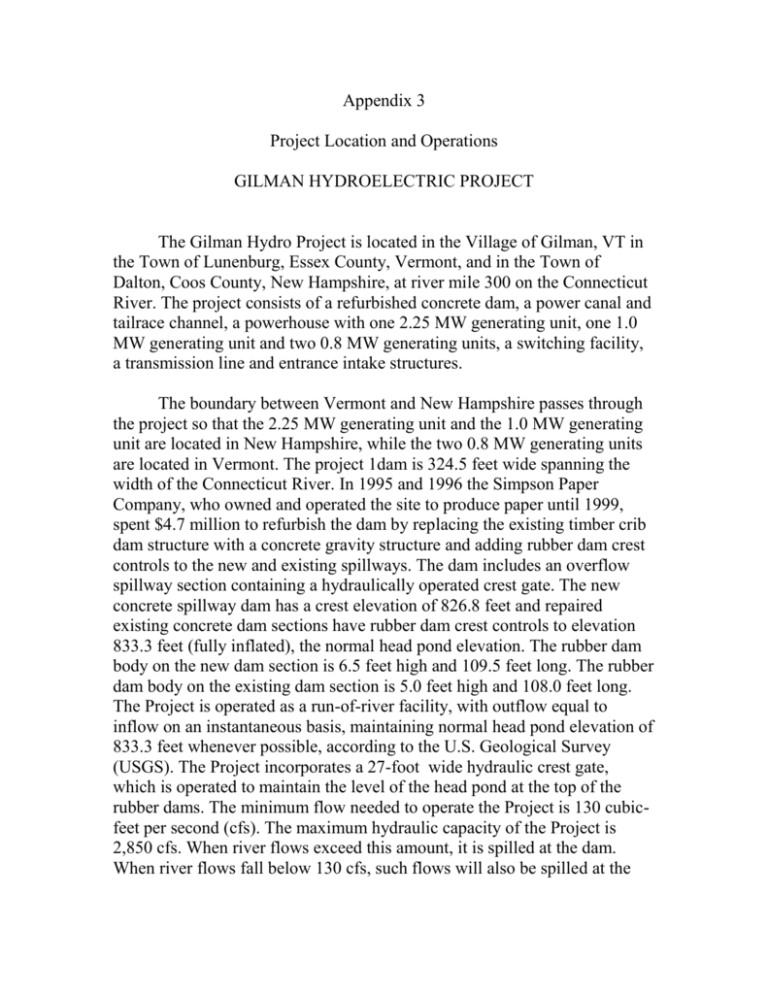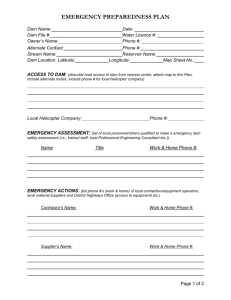Appendix 3
advertisement

Appendix 3 Project Location and Operations GILMAN HYDROELECTRIC PROJECT The Gilman Hydro Project is located in the Village of Gilman, VT in the Town of Lunenburg, Essex County, Vermont, and in the Town of Dalton, Coos County, New Hampshire, at river mile 300 on the Connecticut River. The project consists of a refurbished concrete dam, a power canal and tailrace channel, a powerhouse with one 2.25 MW generating unit, one 1.0 MW generating unit and two 0.8 MW generating units, a switching facility, a transmission line and entrance intake structures. The boundary between Vermont and New Hampshire passes through the project so that the 2.25 MW generating unit and the 1.0 MW generating unit are located in New Hampshire, while the two 0.8 MW generating units are located in Vermont. The project 1dam is 324.5 feet wide spanning the width of the Connecticut River. In 1995 and 1996 the Simpson Paper Company, who owned and operated the site to produce paper until 1999, spent $4.7 million to refurbish the dam by replacing the existing timber crib dam structure with a concrete gravity structure and adding rubber dam crest controls to the new and existing spillways. The dam includes an overflow spillway section containing a hydraulically operated crest gate. The new concrete spillway dam has a crest elevation of 826.8 feet and repaired existing concrete dam sections have rubber dam crest controls to elevation 833.3 feet (fully inflated), the normal head pond elevation. The rubber dam body on the new dam section is 6.5 feet high and 109.5 feet long. The rubber dam body on the existing dam section is 5.0 feet high and 108.0 feet long. The Project is operated as a run-of-river facility, with outflow equal to inflow on an instantaneous basis, maintaining normal head pond elevation of 833.3 feet whenever possible, according to the U.S. Geological Survey (USGS). The Project incorporates a 27-foot wide hydraulic crest gate, which is operated to maintain the level of the head pond at the top of the rubber dams. The minimum flow needed to operate the Project is 130 cubicfeet per second (cfs). The maximum hydraulic capacity of the Project is 2,850 cfs. When river flows exceed this amount, it is spilled at the dam. When river flows fall below 130 cfs, such flows will also be spilled at the dam. The average gross head at the Project is approximately 24 feet from a head pond at elevation 833.3 feet to tail water at elevation 809.0 feet. The Project impoundment at normal pond condition extends approximately 209 miles upstream of the dam to a point just above the confluence of the Johns River, at normal pond condition; the maximum surface area of the impoundment is approximately 130 acres at an elevation of 833.3 feet (USGS). The gross storage capacity at normal pond condition is estimated to be approximately 705 acre-feet, with an average depth of approximately 5.4 feet. The Project powerhouse is located at the northern Vermont end of the dam on the right bank of the Connecticut River and was originally constructed as a ground wood mill. The powerhouse has a substructure of mass concrete with integral water intake draft tubes. The superstructure is of brick construction with steel-frame and timber-frame construction. Project controls and mechanical equipment are located inside the powerhouse. There are four turbines at the Project; the turbine units are numbered 1 through 4, from south to north. Wheel No. 1 is a horizontal tube turbine installed in 1985 and 1986. Wheels Nos. 2, 3 and 4 are contained in turbine pits, each approximately 20 feet wide. Wheel No.2 is a vertical singleregulated propeller turbine with adjustable wicket gates. Wheels Nos. 3 and 4 are horizontal Francis turbines. The combined installed capacity of the Turbine Generators is 4.85 MW. Generators No. 2, 3 and 4 are direct connected to the turbines; Generator No.1 utilizes a speed increaser, allowing the generator to turn at 900 rpm while the turbine turns at 150 rpm. The Project is both manually and automatically operated. The water wheel and Generator No.1, installed in 1985 and 1986, are automatically controlled. The three other turbines and generators (Nos. 2, 3 and 4) are manually controlled. .









